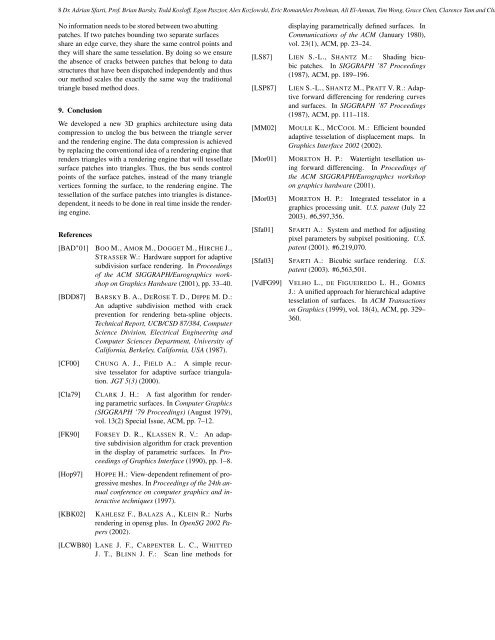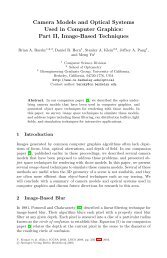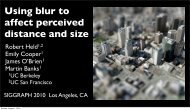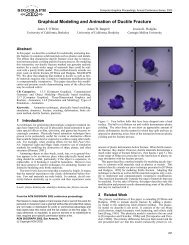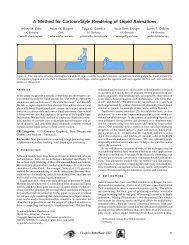Download Paper - Computer Graphics - University of California ...
Download Paper - Computer Graphics - University of California ...
Download Paper - Computer Graphics - University of California ...
You also want an ePaper? Increase the reach of your titles
YUMPU automatically turns print PDFs into web optimized ePapers that Google loves.
8 Dr. Adrian Sfarti, Pr<strong>of</strong>. Brian Barsky, Todd Kosl<strong>of</strong>f, Egon Pasztor, Alex Kozlowski, Eric RomanAlex Perelman, Ali El-Annan, Tim Wong, Grace Chen, Clarence Tam and Chr<br />
No information needs to be stored between two abutting<br />
patches. If two patches bounding two separate surfaces<br />
share an edge curve, they share the same control points and<br />
they will share the same tesselation. By doing so we ensure<br />
the absence <strong>of</strong> cracks between patches that belong to data<br />
structures that have been dispatched independently and thus<br />
our method scales the exactly the same way the traditional<br />
triangle based method does.<br />
9. Conclusion<br />
We developed a new 3D graphics architecture using data<br />
compression to unclog the bus between the triangle server<br />
and the rendering engine. The data compression is achieved<br />
by replacing the conventional idea <strong>of</strong> a rendering engine that<br />
renders triangles with a rendering engine that will tessellate<br />
surface patches into triangles. Thus, the bus sends control<br />
points <strong>of</strong> the surface patches, instead <strong>of</strong> the many triangle<br />
vertices forming the surface, to the rendering engine. The<br />
tessellation <strong>of</strong> the surface patches into triangles is distancedependent,<br />
it needs to be done in real time inside the rendering<br />
engine.<br />
References<br />
[BAD ∗ 01]<br />
[BDD87]<br />
BOO M., AMOR M., DOGGET M., HIRCHE J.,<br />
STRASSER W.: Hardware support for adaptive<br />
subdivision surface rendering. In Proceedings<br />
<strong>of</strong> the ACM SIGGRAPH/Eurographics workshop<br />
on <strong>Graphics</strong> Hardware (2001), pp. 33–40.<br />
BARSKY B. A., DEROSE T. D., DIPPE M. D.:<br />
An adaptive subdivision method with crack<br />
prevention for rendering beta-spline objects.<br />
Technical Report, UCB/CSD 87/384, <strong>Computer</strong><br />
Science Division, Electrical Engineering and<br />
<strong>Computer</strong> Sciences Department, <strong>University</strong> <strong>of</strong><br />
<strong>California</strong>, Berkeley, <strong>California</strong>, USA (1987).<br />
[CF00] CHUNG A. J., FIELD A.: A simple recursive<br />
tesselator for adaptive surface triangulation.<br />
JGT 5(3) (2000).<br />
[Cla79] CLARK J. H.: A fast algorithm for rendering<br />
parametric surfaces. In <strong>Computer</strong> <strong>Graphics</strong><br />
(SIGGRAPH ’79 Proceedings) (August 1979),<br />
vol. 13(2) Special Issue, ACM, pp. 7–12.<br />
[FK90] FORSEY D. R., KLASSEN R. V.: An adaptive<br />
subdivision algorithm for crack prevention<br />
in the display <strong>of</strong> parametric surfaces. In Proceedings<br />
<strong>of</strong> <strong>Graphics</strong> Interface (1990), pp. 1–8.<br />
[Hop97]<br />
[KBK02]<br />
HOPPE H.: View-dependent refinement <strong>of</strong> progressive<br />
meshes. In Proceedings <strong>of</strong> the 24th annual<br />
conference on computer graphics and interactive<br />
techniques (1997).<br />
KAHLESZ F., BALAZS A., KLEIN R.: Nurbs<br />
rendering in opensg plus. In OpenSG 2002 <strong>Paper</strong>s<br />
(2002).<br />
displaying parametrically defined surfaces. In<br />
Communications <strong>of</strong> the ACM (January 1980),<br />
vol. 23(1), ACM, pp. 23–24.<br />
[LS87] LIEN S.-L., SHANTZ M.: Shading bicubic<br />
patches. In SIGGRAPH ’87 Proceedings<br />
(1987), ACM, pp. 189–196.<br />
[LSP87]<br />
[MM02]<br />
LIEN S.-L., SHANTZ M., PRATT V. R.: Adaptive<br />
forward differencing for rendering curves<br />
and surfaces. In SIGGRAPH ’87 Proceedings<br />
(1987), ACM, pp. 111–118.<br />
MOULE K., MCCOOL M.: Efficient bounded<br />
adaptive tesselation <strong>of</strong> displacement maps. In<br />
<strong>Graphics</strong> Interface 2002 (2002).<br />
[Mor01] MORETON H. P.: Watertight tesellation using<br />
forward differencing. In Proceedings <strong>of</strong><br />
the ACM SIGGRAPH/Eurographcs workshop<br />
on graphics hardware (2001).<br />
[Mor03] MORETON H. P.: Integrated tesselator in a<br />
graphics processing unit. U.S. patent (July 22<br />
2003). #6,597,356.<br />
[Sfa01]<br />
SFARTI A.: System and method for adjusting<br />
pixel parameters by subpixel positioning. U.S.<br />
patent (2001). #6,219,070.<br />
[Sfa03] SFARTI A.: Bicubic surface rendering. U.S.<br />
patent (2003). #6,563,501.<br />
[VdFG99]<br />
VELHO L., DE FIGUEIREDO L. H., GOMES<br />
J.: A unified approach for hierarchical adaptive<br />
tesselation <strong>of</strong> surfaces. In ACM Transactions<br />
on <strong>Graphics</strong> (1999), vol. 18(4), ACM, pp. 329–<br />
360.<br />
[LCWB80] LANE J. F., CARPENTER L. C., WHITTED<br />
J. T., BLINN J. F.: Scan line methods for


